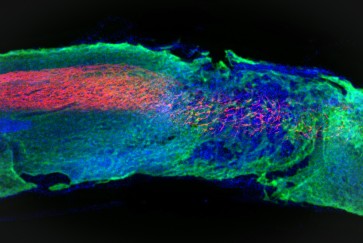One of only a handful of Native birchbark canoe builders remaining in the U.S., Northwestern University artist-in-residence Wayne Valliere is sharing the traditional Native American art, unchanged in three millennia, with a group of students on the Evanston campus.
Valliere was first exposed to canoe making at the age of 14 and built his first canoe two years later. He learned the craft from his elders in his Lac du Flambeau Band of Lake Superior Ojibwe. It is a skill that was once commonly passed from generation to generation. But by the 1900s, the knowledge began to deplete quickly. Now, Valliere says he is one of six remaining birch bark canoe builders among the Anishinaabeg people.
Valliere, whose native name is Mino-Giizhig, which means good sky, is working to keep the canoe building craft alive by sharing his skills and knowledge with students at Northwestern. He is an artist-in-residence with the Center for Native American and Indigenous Research (CNAIR). Over the last few weeks, with the help of students, Valliere began building a traditional 16-foot birchbark canoe.
“At one time, every family knew how to build birchbark canoes. It was as common as people driving cars today,” Valliere said.
Earlier this summer, a group of Northwestern faculty, staff and students, along with members of the urban Native community in Chicago, traveled to Valliere’s Lac du Flambeau Reservation in northern Wisconsin to help gather materials used to create the canoe — cedar for the ribs, spruce roots for the stitching, pine pitch to seal the seams and, of course, birchbark.
Alone weak. Together strong
“The teaching is that the birchbark is very fragile. It’s like paper. Cedar is also fragile. The roots can snap. But when you put these things together, they become very strong,” Valliere said of the canoe’s materials. “A teaching that we use as Anishinaabe people is that we use things that, alone are weak, but together are strong. These teachings are duplicated throughout nature for us. That’s how we learned to live in this harsh environment.”
“Our birchbark is so important because it signifies our identity,” Valliere said. “It’s our connection to our past. It’s very important that we don’t lose this craft because it connects us to our grandmother, the Earth.”
Before any trees are harvested for wood, the Ojibwe must first ask the spirit of a cedar tree, which will supply the ribs for the canoe, if they can take it.
“We give that respect, and the tree allows us to harvest it in a good way,” he said. “Birchbark is a great gift that was given to our tribe a long time ago; It was going to be a protector of our people and would serve us in a great way.”
The Ojibwe Tribe used birchbark to build homes, cradles, caskets and more.
“We kept our history scratched on winter birchbark in pictographs that foretold our history and way of life,” Valliere explained.
Teaching is critical to the future
Valliere said teaching Northwestern students this rich history and the cultural tradition of canoe building is critical to the future of the planet. “It’s so important to bring awareness to our changing environment and to make sure those environments are still here for Northwestern graduates’ great grandchildren and generations beyond so that they will be able to breathe clean air and drink clean water. Without our environment, we have nothing.”
It’s so important to bring awareness to our changing environment and to make sure those environments are still here for Northwestern graduates’ great grandchildren and generations beyond.”
The canoe Valliere is building at Northwestern is his 38th canoe. Once completed, the canoe will remain at Northwestern. Plans call for it to be launched onto Lake Michigan at sunrise on Friday, Oct. 29 following a drum and prayer ceremony.
"Our canoe team faced so many challenges involving space, tools, and access to materials. The project would not have happened without the help of Josh Ippel and the Art Theory and Practice department," said Patty Loew, director of CNAIR.
Valliere is a 2020 National Endowment for the Arts Heritage Fellow. When he isn’t teaching canoe making, he can be found sharing other traditional skills including beading, quillwork and drum making. He is also a respected singer and storyteller.
The Center for Native American and Indigenous Research was established in 2017 through the Weinberg College of Arts and Sciences. CNAIR is Northwestern’s primary institutional space dedicated to advancing scholarship, teaching, learning and artistic or cultural practices related to Native American and Indigenous communities, priorities, histories and lifeways.

